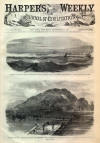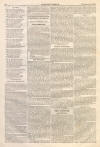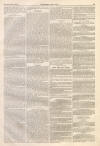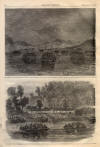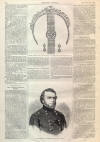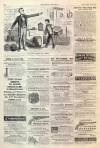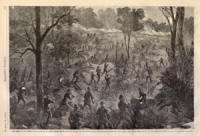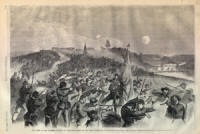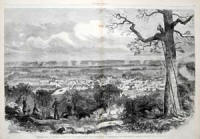General Washburne
|
|
This Site:
|
HARPER'S WEEKLY. [NOVEMBER 28, 1863. 764 BRIDAL PARURE OF MRS. SENATOR SPRAGUE (NEE MISS CHASE), MADE BY TIFFANY & CO.Edward thanked him, and put on his hat directly, for he could not disguise from himself that this visitor might be Alfred Hardie. Indeed, what more likely? Messrs. Hurd and Peterson always tried to stay one another out whenever they met at 66 Pembroke Street. However, to make sure of not leaving Julia alone, Edward went in and asked them both to luncheon, at which time he said he should be back. As he walked rapidly to the station he grew more and more convinced that it was Alfred Hardie. And his reflections ran like this: "What a head-piece mamma has! But it did not strike her he would come to me first. Yet how plain that looks now: for of course I'm the duffer's my clew to Julia. These madmen are no fools though. And how quiet he was that night! And he made papa go down the ladder first: that was the old Alfred Hardie. He was always generous: vain, overbearing, saucy, but noble with it all. I liked him: he was a man that showed you his worst, and let you find his best out by degrees. He hated to be beat: but that's no crime. He was a beautiful oar: and handled his mawleys uncommon; he sparred with all the prize-fighters that came to Oxford, and took punishment better than you would think; and a wonderful quick hitter; Alec Reid owned that. Poor Taff Hardie! And when I think that God has overthrown his powerful mind, and left me mine, such as it is! But the worst is my having gone on calling him 'the Wretch' all this time: and nothing too bad for him. I ought to be ashamed of myself. It grieves me very much. 'When found make a note on:' never judge a fellow behind his back again." Arrived at the station, he inquired whether his friend had called again, and was answered in the negative. He waited a few minutes, and then, with the superintendent's permission, wrote a note to Alfred, inviting him to dine at Simpson's at six, and left it with the firemen. This done, he was about to return home, when another thought struck him. He got a messenger, and sent off a single line to Dr. Wolf, to tell him Alfred Hardie would be at Simpson's at seven o'clock. But when the messenger was gone, he regretted what he had done. He had done it for Alfred's good; but still it was treason. He felt unhappy, and wended his way homeward disconsolately, realizing more and more that he had not brains for the difficulties imposed upon him. On entering Pembroke Street he heard a buzz: He looked up, and saw a considerable crowd collected in a semicircle. "Why that is near our house," he said, and quickened his steps. When he got near to his house he saw that all the people's eyes were bent on No. 66. He dashed into the crowd. "What on earth is the matter?" he cried. "The matter? Plenty's the matter, young man," cried one. "Murder's the matter," said another. At that he turned pale as death. An intelligent man saw his violent agitation, and asked him hurriedly if he belonged to the house. "Yes. For God's sake what is it?" "Make way there!" shouted the man. "He belongs. Sir, a madman has broke loose and got into your house. And I'm sorry to say he has just killed two men." "With a pistol," cried two, speaking together. MISS CHASE'S WEDDING JEWELS.SINCE the famous Diamond Wedding of the Cuban Oviedo in this city, some three years since, no similar event has created so lively a sensation in the fashionable world as that upon which the beautiful ornaments illustrated in the accompanying cut were worn—the marriage of Senator and ex-Governor Sprague, of Rhode Island, to Miss Kate, eldest daughter of the Secretary of the Treasury. The articles engraved are the Tiara, Bracelet, and Ear-rings of the bridal parure. The material of which they were composed is pearls and diamonds, and the gold work is so delicately wrought that the eye catches little else, at a cursory view, than these precious jewels. The Tiara, it will be observed, is especially rich and artistic—a combination of intrinsic and aesthetic features not invariably attained. In addition to such desirable qualities it has likewise a curiously-achieved adaptedness which is not obvious from the sketch. The reader will note the base line of rare pearls; but he does not know, until advised of the fact, that this Orient stream can be diverted from its golden strand and made to encircle the fair neck of its possessor. The exquisite spray of orange leaves and blossoms en each frontal has likewise a ticket of leave, whenever occasion requires its service as a distinct head ornament; and, finally, the zenith itself—"the true lover's knot" of brilliants supporting the mammoth, arrow-riven, heart-shaped pearl—only retains its place at the will of the wearer; the cunning mechanism of the goldsmith having so established its relations to the hidden frame-work, that at the word presto it is detached, and, by the addition of a pin and catch, changed into an unique Brooch. Thus this beautiful Tiara is either available upon especially grand occasions as an entirety almost unequaled for gracefulness and value —or in each and all of its minor offices as necklace, hair-pins, and brooch. The subjects of the illustration (as, in fact, the entire detail of jeweled ornaments for Miss Chase) were furnished by Tiffany & Co., of New York. The splendid pearl that constitutes the very front of the Tiara, larger perhaps than any in the country, and in symmetry and rare brilliancy quite warranting the old Latin term Unio, has been for same time one of those treasures for the garnering of which that establishment is famous. The Bracelet and Ear-rings in the cut, of course less ambitious in design than the Tiara, are still of exemplary beauty and quality of material. The quiet eclat of this fine parure is equally worthy the fine taste of the lady, whose features it will henceforth adorn, and of the appreciating artist to whom its production has been with such good result intrusted. MAJOR-GENERAL WASHBURNE.WE publish herewith a portrait of MAJOR-GENERAL C. C. WASHBURNE, who commands a division in General Banks's army of the Gulf, and is distinguishing himself in the work of restoring Western Louisiana and Texas to the Union. General Washburne is one of that great family of Washburnes which has furnished so many good and great men to the country in the present age. He was born at Livermore, Maine, on April 22, 1818, and is consequently nearly 46 years of age. He studied law, and at an early period of his life removed to Wisconsin, where he settled. He was sent by the people of that State to the Thirty-fourth, Thirty-fifth, and Thirty-sixth Congresses, and acquired reputation as a substantial man. He was less prominent than his brother from Illinois, but was not less esteemed by his fellow-members and his constituents. Shortly after the outbreak of the war, Mr. Washburne offered his services to the Government, and was appointed to a command on 16th July, 1862. He served with distinction under Grant, and was present at many of the battles of the Western campaign. On 29th November, 1862, he was appointed a Major-General of Volunteers, and soon afterward assumed the command he at present holds in Louisiana. General Washburne is a fine soldier, and we shall doubtless hear more of him as the campaign in the far South progresses. THE ARMY OF THE POTOMAC.ON page 765 we publish an illustration of the CAPTURE OF THE FORTIFICATIONS ON THE RAPPAHANNOCK NEAR THE RAILWAY BRIDGE, by Major-General Sedgwick. Our picture is from a sketch by Mr. A. R. Waud. The affair was very neat and brilliant. The rebels were surprised, and a large number of prisoners taken, as well as the forts, from under General Lee's nose. General Meade's operations of late have been remarkably successful, and entitle him to high praise as a commander. When the President heard of the operations on the Rappahannock he sent a telegraphic dispatch to General Meade in these terms: "I have heard of your operations on the Rappahannock, and wish to say, Well done!A. LINCOLN." This characteristic dispatch was communicated to the troops in an order of the day, and created the greatest enthusiasm among our brave boys. At Richmond, on the contrary, the defeats of the rebel forces on the Rappahannock have created much annoyance. The papers which were full of eulogies of Lee a few weeks since now sneer at or abuse him. The Enquirer publishes a long list of Confederate surrenders, ending with the recent affairs on the Rappahannock, and draws therefrom inferences any thing but complimentary to the valor and endurance of the chivalry. CHATTANOOGA.WE devote considerable space this week to republishing sketches sent us from Chattanooga by our special artist, Mr. Theo. R. Davis. They will be found to convey a pretty complete view of the situation in that part of the country, as well as of the recent events which have taken place. We subjoin Mr. Davis's letters: THE SITUATION AT CHATTANOOGA.—SKETCHED FROM THE SIGNAL-STATION ON CAMERON'S HILL."CHATTANOOGA, Oct. 28, 1863. "The difficulty of showing our almost surrounded position in a sketch for a time puzzled me. And when I was one day told by my friends of the Signal Corps 'that from Cameron's Hill Station I could see the whole,' I started for that place, under guidance of Lieutenants Ayres and Bachtell, and obtained the sketch now presented—which shows the river above and below us, and the distant camps of the rebels all around, as well as a complete view of the town. THE CHARGE OF THE THIRTY-THIRD MASSACHUSETTS AND SEVENTY-THIRD OHIO REGIMENTS."HEAD-QUARTERS COLONEL BUSHBECK'S BRIGADE, LOOKOUT VALLEY, Oct. 30, 1863. "On the night of the 28th of October the troops of General Hooker occupied a portion of Lookout Valley. Shortly after midnight it was discovered that the rebels had occupied a strong post which placed our troops in a very uncomfortable, if not untenable, position. General Hooker at once ordered the Thirty-third Massachusetts and Seventy-third Ohio to storm and carry the place with the bayonet. This they did in the most gallant manner. In many places the brave fellows had to drag themselves up by grasping shrubs and roots. "When they reached the top of the ridge the explosions of musketry burned the contending troops. The captured rebels say that it was a disgrace to them that the place was taken, but they could not help it; for, said they, 'you kept coming, and the next we knew you were right among us.' "THE OPENING OF THE TENNESSEE RIVER. "HEAD-QUARTERS MAJOR-GENERAL GORDON GRANGER, CHATTANOOGA, Oct. 30. The evacuation of Lookout Mountain, some weeks since, by order of General Rosecrans, gave to the rebels complete command of the river between this place and Bridgeport. "General Grant, in taking command, found that the river could be opened to within a short distance of this place; and to accomplish this was his first work. A portion of our forces crossed at Bridgeport, and came up the south bank of the river. Other troops were sent at night to a point on the north bank of the river below the intended crossing-place. "The brigade of General Hazen was placed in pontoons and floated at night to a point below, and out of the range of the rebel batteries upon Lookout Mountain, where they arrived just after dawn. A number of the boats landed at a point just below the place where the bridge now is, and at a rebel picket-station. The pickets ran off, shouting, Yanks! Yanks!! Yanks!!!' their pace being accelerated by a number of musket-balls from the before-mentioned Yanks. "The building of the bridge was accomplished most successfully, though for some time our men worked under a severe fire from the rebel batteries. "The bridge is the best work of the kind that has been constructed by the army at this point, and was built by the Michigan Engineers, under the supervision of Captains Fox and Dresser. Captain D. is a West Point officer, and while at the Academy was Captain of Cadets, the present General Kilpatrick being one of the other captains. He is now upon the staff of General South, Chief Engineer of this Department. "THE STEAMER 'POINT ROCK' RUNNING DOWN THE TENNESSEE RIVER TO BRIDGEPORT. "HEAD-QUARTERS MAJOR-GENERAL GORDON GRANGER, CHATTANOOGA, Oct. 31, 1863. "The entire impracticability of supplying the army at this point by means of wagons, rendered it an absolute necessity to open the river from Bridgeport to a point as near this place as practicable. "This has now been accomplished, and the boats are bringing us each day a supply to which we have hitherto been strangers. "The Point Rock, on her trip down the river, was made a target for hundreds of rebel rifles, the balls from which did no damage. Other steamboats are to be placed upon the river at the earliest moment." MAJOR-GENERAL C. C. WASHBURNE.—[PHOTOGRAPHED BY BRADY.]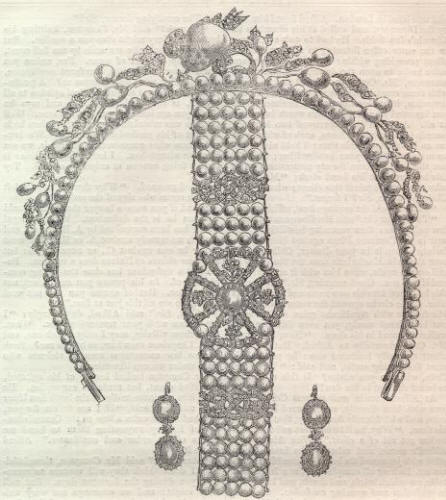 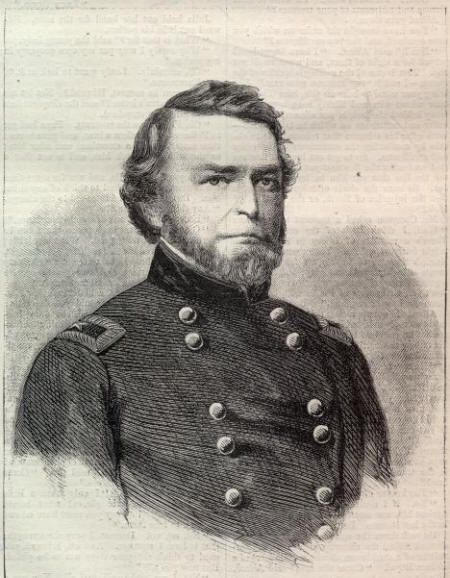 |
||||||||||||||||||
|
|
||
|
|
Site Copyright 2003-2018 Son of the South. For Questions or comments about this collection, contact paul@sonofthesouth.net |
|
|
Are you Scared and Confused? Read My Snake Story, a story of hope and encouragement, to help you face your fears. |
||
